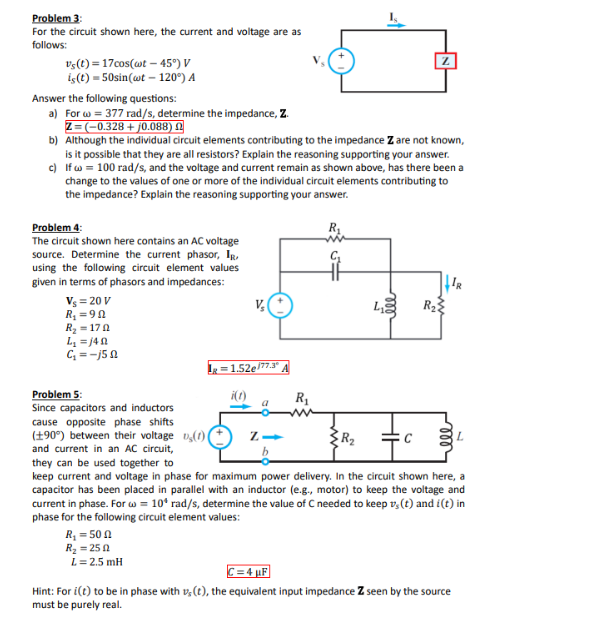Problem 3: For the circuit shown here, the current and voltage are as follows: vs(t) 17cos(wt-45°) V is(t) 50sin(wt-120°) A Answer the following questions: a) For w=377 rad/s, determine the impedance, Z. Z=(-0.328 + j0.088) b) Although the individual circuit elements contributing to the impedance Z are not known, is it possible that they are all resistors? Explain the reasoning supporting your answer. c) If w=100 rad/s, and the voltage and current remain as shown above, has there been a change to the values of one or more of the individual circuit elements contributing to the impedance? Explain the reasoning supporting your answer. Problem 4: The circuit shown here contains an AC voltage source. Determine the current phasor, IR, using the following circuit element values given in terms of phasors and impedances: Vs=20V R₁ =9 R₂-170 L₁ =140 C₁ = -j5n L₁ R₂ Problem 5: Since capacitors and inductors cause opposite phase shifts (+90°) between their voltage (1) and current in an AC circuit, =1.52e77.3° a R₁ R₂ they can be used together to keep current and voltage in phase for maximum power delivery. In the circuit shown here, a capacitor has been placed in parallel with an inductor (e.g., motor) to keep the voltage and current in phase. For w = 10* rad/s, determine the value of C needed to keep v(t) and i(t) in phase for the following circuit element values: R₁ = 50 R₂ =250 L= 2.5 mH C=4F Hint: For i(t) to be in phase with s(t), the equivalent input impedance Z seen by the source must be purely real.
Problem 3: For the circuit shown here, the current and voltage are as follows: vs(t) 17cos(wt-45°) V is(t) 50sin(wt-120°) A Answer the following questions: a) For w=377 rad/s, determine the impedance, Z. Z=(-0.328 + j0.088) b) Although the individual circuit elements contributing to the impedance Z are not known, is it possible that they are all resistors? Explain the reasoning supporting your answer. c) If w=100 rad/s, and the voltage and current remain as shown above, has there been a change to the values of one or more of the individual circuit elements contributing to the impedance? Explain the reasoning supporting your answer. Problem 4: The circuit shown here contains an AC voltage source. Determine the current phasor, IR, using the following circuit element values given in terms of phasors and impedances: Vs=20V R₁ =9 R₂-170 L₁ =140 C₁ = -j5n L₁ R₂ Problem 5: Since capacitors and inductors cause opposite phase shifts (+90°) between their voltage (1) and current in an AC circuit, =1.52e77.3° a R₁ R₂ they can be used together to keep current and voltage in phase for maximum power delivery. In the circuit shown here, a capacitor has been placed in parallel with an inductor (e.g., motor) to keep the voltage and current in phase. For w = 10* rad/s, determine the value of C needed to keep v(t) and i(t) in phase for the following circuit element values: R₁ = 50 R₂ =250 L= 2.5 mH C=4F Hint: For i(t) to be in phase with s(t), the equivalent input impedance Z seen by the source must be purely real.
Power System Analysis and Design (MindTap Course List)
6th Edition
ISBN:9781305632134
Author:J. Duncan Glover, Thomas Overbye, Mulukutla S. Sarma
Publisher:J. Duncan Glover, Thomas Overbye, Mulukutla S. Sarma
Chapter2: Fundamentals
Section: Chapter Questions
Problem 2.18P: Let a series RLC network be connected to a source voltage V, drawing a current I. (a) In terms of...
Question
100%
Answer all questions and show full working. Thank you

Transcribed Image Text:Problem 3:
For the circuit shown here, the current and voltage are as
follows:
vs(t) 17cos(wt-45°) V
is(t) 50sin(wt-120°) A
Answer the following questions:
a) For w=377 rad/s, determine the impedance, Z.
Z=(-0.328 + j0.088)
b) Although the individual circuit elements contributing to the impedance Z are not known,
is it possible that they are all resistors? Explain the reasoning supporting your answer.
c) If w=100 rad/s, and the voltage and current remain as shown above, has there been a
change to the values of one or more of the individual circuit elements contributing to
the impedance? Explain the reasoning supporting your answer.
Problem 4:
The circuit shown here contains an AC voltage
source. Determine the current phasor, IR,
using the following circuit element values
given in terms of phasors and impedances:
Vs=20V
R₁ =9
R₂-170
L₁ =140
C₁ = -j5n
L₁
R₂
Problem 5:
Since capacitors and inductors
cause opposite phase shifts
(+90°) between their voltage (1)
and current in an AC circuit,
=1.52e77.3°
a
R₁
R₂
they can be used together to
keep current and voltage in phase for maximum power delivery. In the circuit shown here, a
capacitor has been placed in parallel with an inductor (e.g., motor) to keep the voltage and
current in phase. For w = 10* rad/s, determine the value of C needed to keep v(t) and i(t) in
phase for the following circuit element values:
R₁ = 50
R₂ =250
L= 2.5 mH
C=4F
Hint: For i(t) to be in phase with s(t), the equivalent input impedance Z seen by the source
must be purely real.
Expert Solution
This question has been solved!
Explore an expertly crafted, step-by-step solution for a thorough understanding of key concepts.
This is a popular solution!
Trending now
This is a popular solution!
Step by step
Solved in 2 steps with 4 images

Recommended textbooks for you

Power System Analysis and Design (MindTap Course …
Electrical Engineering
ISBN:
9781305632134
Author:
J. Duncan Glover, Thomas Overbye, Mulukutla S. Sarma
Publisher:
Cengage Learning

Power System Analysis and Design (MindTap Course …
Electrical Engineering
ISBN:
9781305632134
Author:
J. Duncan Glover, Thomas Overbye, Mulukutla S. Sarma
Publisher:
Cengage Learning